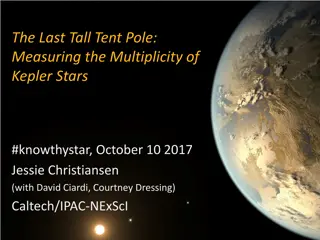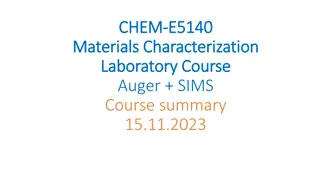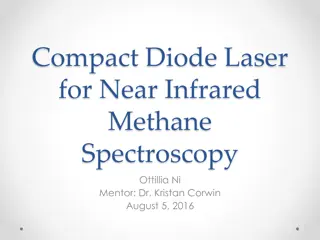NMR Spectroscopy for Structure Identification
NMR spectroscopy is a powerful tool in determining the structure of organic compounds. This summary outlines the process of using 1H NMR spectroscopy to identify an unknown compound, detailing steps such as determining different proton types, analyzing integration data, and interpreting splitting pa
3 views • 40 slides
Hardware Demonstration and Improvements of the Stellar Positioning System
The Hardware Demonstration and Improvements of the Stellar Positioning System (SPS) involve utilizing ancient celestial navigation techniques for lunar exploration. SPS combines central-body-relative observation with star-field observation to determine absolute position, reducing mass/power impacts
6 views • 14 slides
Slitless Stellar Spectroscopy with the SA100 Grating Procedures
Explore the world of slitless stellar spectroscopy with the SA100 grating as detailed by Anthony Harding in the ongoing creation of the Harding Spectra Library. Learn about the equipment used, the process of determining instrument response, capture procedures, and stacking techniques for obtaining s
1 views • 30 slides
NMR Spectroscopy of Paramagnetic Molecules
NMR spectroscopy of paramagnetic molecules is influenced by the presence of unpaired electrons, leading to broadened spectra and complex coupling mechanisms. Quadrupolar nuclei, with spins greater than 1/2, play a significant role in the relaxation and splitting of NMR signals. The interaction betwe
0 views • 19 slides
Raman Spectroscopy: Principles and Applications
Raman spectroscopy is a technique used for chemical analysis by exciting molecular vibrations with light. This inelastic scattering of light allows researchers to gather valuable information about samples. The method relies on the Raman effect, discovered by C.V. Raman, which involves the emission o
1 views • 14 slides
UV/Visible Spectroscopy and Electromagnetic Radiation
Spectroscopy is the study of the interaction of matter with light, specifically UV and visible radiation. Electromagnetic radiation, consisting of photons, transmits energy through space as waves with oscillating electric and magnetic fields. The relationship between wavelength and frequency is key,
1 views • 50 slides
The Basics of 13C NMR Spectroscopy
Nuclear Magnetic Resonance (NMR) Spectroscopy is a powerful analytical tool used in chemistry to study the structure of molecules. This summary focuses on the application of 13C NMR spectroscopy, which provides valuable information about carbon atoms in a compound. The low natural abundance of carbo
0 views • 36 slides
Basic Concepts of Hyperspectral Imaging and Spectroscopy
Exploring the fundamental principles of hyperspectral imaging and spectroscopy, this content covers topics such as interference, diffraction, spectrometer workings using diffraction gratings, and wave properties. Lectures by Adjunct Professor Fred Sigernes delve into topics like basic spectroscopy,
0 views • 21 slides
Structural Elucidation of Chemical Compounds Using Spectroscopy Techniques
This presentation discusses the various types of spectroscopy techniques such as UV-Visible, IR, Raman, NMR, and others used for elucidating the structure of chemical compounds. It covers the identification of molecule shapes like AB2, AB3, and AB4, with a focus on linear and non-linear structures.
1 views • 18 slides
NMR Spectroscopy and Chemical Shifts
Nuclear Magnetic Resonance (NMR) spectroscopy is a powerful technique for analyzing molecular structures based on the chemical shifts of protons. In an NMR spectrum, peaks correspond to different protons in a compound, with their positions, intensities, and spin-spin splitting providing valuable inf
0 views • 19 slides
Unveiling the Impact of Stellar Multiplicity on Exoplanet Detection
Exploring the effects of stellar multiplicity on exoplanet detection, this research highlights the challenges in accurately measuring Earth-sized planets and proposes high-resolution imaging as a solution. By conducting a survey of Kepler non-host stars, significant insights have been gained, sugges
0 views • 9 slides
Development of CHARA/SPICA Project for Stellar Astrophysics Research
CHARA/SPICA project history spans from funding requests to the realization of SPICA instruments, including SPICA-FT and SPICA-VIS. Scientific requirements focus on stellar physics, visible interferometry, and large surveys for stellar parameters determination, with detailed specifications for fringe
0 views • 6 slides
Host Stars and Their Importance in Exoplanet Research
Host stars play a crucial role in determining the physical parameters of planets they host, impacting exoplanet characterization and planet formation understanding. Data from astrometry, photometry, and spectroscopy, combined with stellar evolutionary models, help derive host star properties critica
1 views • 51 slides
Stellar Structure in Fundamental Astrophysics
Exploring the intriguing world of stellar structure and energy production in stars. Discover the equilibrium of forces, hydrostatic equilibrium, energy transport mechanisms, boundary conditions, equations of state, and nuclear reactions shaping the dynamics of stars. Unveil the mysteries behind the
0 views • 39 slides
Techniques for Hadron Spectroscopy Studies at LHCb
Hadron spectroscopy studies at LHCb focus on searching for new hadrons, measuring their properties like lineshape, lifetime, and decay modes. The LHCb detector is optimized for collecting, reconstructing, and identifying signals to improve knowledge about hadron spectroscopy. Development of data ana
1 views • 30 slides
Nuclear Decays and Reactions in Stellar Astrophysics
Nuclear decays and reactions, driven by weak interactions, are vital in stellar astrophysics. Various processes like bound-state beta-decay impact nucleosynthesis and cosmochronology. Specific processes in stars involve capture reactions, electron capture, and neutrino-nucleus interactions. Stellar
0 views • 22 slides
Stellar Variability Effects in Exoplanet Studies
Exploring the impact of stellar variability on exoplanet transits and eclipses, this content delves into strategies for disentangling signals in phase curves. Factors such as stellar brightness, size, and stability play crucial roles. Illustrations and studies by Pont et al. shed light on phenomena
0 views • 7 slides
Fascinating Insights into Stellar Distances and Parallax Measurements
Delve into the vast distances between stars, such as Alpha Centauri and Proxima Centauri, captured through intriguing images. Explore the concept of parallax and its role in estimating stellar distances relative to our Sun. Understand the challenges astronomers face in measuring these immense distan
1 views • 7 slides
Stellar Properties: Distance, Brightness, and Flux
Explore the fascinating realm of stellar astronomy with topics such as stellar parallax, magnitude scales, luminosity, radiant flux, and the inverse square law. Learn about measuring distances to stars, comparing their brightness, and understanding the energy they emit into space. Dive into the intr
0 views • 31 slides
Advances in Baryon Spectroscopy and Hadronic Matter Studies
Discussions at the meeting focused on interpreting HADES results for e+e- and meson production in hadronic reactions, with studies involving proton, pion, light, and heavy ion beams. The role of time-like electromagnetic transitions, baryon spectroscopy, and connecting hadronic matter studies were e
0 views • 12 slides
Auger Spectroscopy: Techniques and Applications in Materials Characterization
Auger spectroscopy, named after Pierre Auger, is a powerful technique for analyzing the surface composition of materials at the atomic level. This method involves the emission of Auger electrons and characteristic x-rays upon interaction with an electron beam. It offers high surface sensitivity, ena
0 views • 29 slides
Overview of Auger Spectroscopy in Materials Characterization
Auger spectroscopy is a powerful technique used for materials characterization, involving the emission of Auger electrons to analyze the elemental composition of a sample. Named after Pierre Auger, this method provides valuable information about the surface properties of materials. The technique is
0 views • 24 slides
Solutions for Asteroid Location Determination in Stellar Systems
Detailed guidance is provided on how to determine the location of an asteroid in relation to stars in a stellar system. The process involves different scenarios such as unique solutions, double solutions, and four solutions, each requiring specific steps for accurate identification. Matching events,
0 views • 15 slides
Implications of Star Formation in the Central Parsec of Our Galaxy with Subaru Observations
Researchers presented implications of star formation in the central parsec of our Galaxy using Subaru observations at the 2014 Subaru Users Meeting. The study focused on the supermassive black hole Sgr A* and the challenges posed by conditions in the Galactic Center for star formation. Various scena
1 views • 30 slides
Advanced Emission Line Pipeline for Stellar Kinematics Analysis
This comprehensive pipeline includes processes for stellar kinematics, continuum fitting, Gaussian line fitting, and analysis of SAMI-like cubes. It also covers Gaussian fitting techniques, parameter mapping, and potential issues. The pipeline features detailed steps and strategies for accurate anal
0 views • 10 slides
Insights into Theoretical Approaches in NMR Spectroscopy
Theoretical approaches in NMR spectroscopy encompass diverse methods, each with varying degrees of approximation but yielding correct results within their validity. Techniques such as transition probabilities using the time-dependent perturbation theory, Zeeman interaction for energy level transitio
0 views • 32 slides
Practical Advances in Pharmaceutical Analysis Using Spectroscopy Techniques
This comprehensive guide covers various spectroscopy techniques, including UV-Vis and IR spectroscopy, as well as electrochemical analysis and flame photometry, for pharmaceutical analysis. It delves into the fundamentals of molecular spectroscopy, discussing electromagnetic radiation, quantum energ
0 views • 19 slides
Unveiling Dark Nebulae and Stellar Formation in Space
Dark Nebulae like the Coalsack Nebula and Snake Nebula are dense interstellar clouds where light cannot pass through. Comprised of tiny dust particles coated in frozen gases, they serve as precursors to stellar nurseries, where protostars begin to form and evolve. Learn about these enigmatic cosmic
0 views • 11 slides
Impact of M Dwarf Stellar Wind on Atmospheric Escape of a Mars-like Exoplanet
The study explores how the stellar wind from M dwarf stars affects the atmospheric escape of a Mars-like planet, focusing on the potential habitability of such exoplanets. Computer simulations utilizing stellar wind parameters provide insights into ion escape and the varying conditions at different
0 views • 19 slides
Lecture 7b
Nuclear Magnetic Resonance (NMR) Spectroscopy is a powerful technique used to analyze atomic structures in molecules. This technique, developed by Felix Bloch and Edward Purcell, has revolutionized the field of chemistry. Understanding the physical background of NMR spectroscopy is crucial for inter
3 views • 19 slides
MR SPECTROSCOPY
MR Spectroscopy is a technique for analyzing in vivo chemical environments to study neurophysiology and neurochemistry. This quantitative noninvasive assay allows for the identification of various metabolites such as NAA, choline, creatine, lipids, and lactates. Data collected are analyzed in the ti
0 views • 22 slides
Reach for the Stars 2025: Astronomy and Stellar Evolution Overview
Explore the world of Astronomy and Reach for the Stars with a detailed overview of topics like Stellar Evolution, Stellar Classification, and Kepler's Law. Discover the scientific principles associated with observatories and enhance your knowledge of late stage stellar evolution. Participants can te
0 views • 7 slides
Compact Diode Laser for Near Infrared Methane Spectroscopy
Explore the development of a compact diode laser for near infrared methane spectroscopy, including motivation, challenges, methane absorption spectroscopy, and assembling the laser components. Learn about the interior of the diode laser and the powering mechanisms involved in this innovative technol
0 views • 11 slides
Applications of Mossbauer Spectroscopy in Chemistry Studies
Explore the principles and applications of Mossbauer spectroscopy in chemistry through the work of Dr. A. Simi, Assistant Professor at St. Joseph's College, Trichy. Learn about nuclear gamma resonance spectroscopy, recoil effects, and the impact of momentum conservation in emission processes. Discov
0 views • 81 slides
Photonics-Based Terahertz Spectroscopy System for Pharmaceutical Tablet Manufacturing
Addressing challenges in pharmaceutical tablet manufacturing through terahertz spectroscopy. Learn about the photonics-based wideband spectroscopy system developed by Prof. Guillermo Carpintero for monitoring and optimizing the manufacturing process. Find out how this innovative technology helps in
0 views • 4 slides
Understanding Raman Spectroscopy Basics and Applications
Explore the fundamentals of Raman spectroscopy, a valuable analytical technique complementary to IR spectroscopy. Learn about the principles, types of Raman scattering, active Raman vibrations, and how Raman spectra differ from IR spectra. Discover the unique capabilities and applications of Raman s
0 views • 19 slides
NMR Spectroscopy: 13C-NMR Introduction and Chemical Shift Analysis
Explore the principles of 13C-NMR spectroscopy, including the unique features of carbon-13 nuclei, proton decoupling, chemical shift ranges, functional group identifications, and the effects of environmental factors on chemical shifts. Enhance your understanding of NMR spectroscopy for chemical anal
0 views • 21 slides
Core-Level Spectroscopy of Solids: Energy Ranges and Measurements
Explore the energy ranges and spectroscopic measurements in core-level spectroscopy of solids, covering topics such as X-ray Absorption Spectroscopy (XAS) and Photoelectron Spectroscopy (XPS). Learn how XPS measures the energy of occupied orbitals and its implications for oxidation state determinati
0 views • 11 slides
Exploring Spectral Analysis and Modern Stellar Spectra
Explore the world of observational techniques in astronomy with a focus on spectroscopy, redshift, and modern stellar spectra. Dive into topics such as cosmic microwave background, CMB developments, neutrino detectors, gravitational wave detectors, and more. Unveil the mysteries of redshift, plate s
0 views • 23 slides
Disruption of Dark Matter Minihalos by Stellar Encounters Research
Explore the disruptive effects of successive stellar encounters on dark matter minihalos, impacting direct dark matter detection possibilities. Join the investigation into axion minihalos and their NFW profile through simulations and analytical models of mass disruption due to stellar interactions.
0 views • 18 slides







































